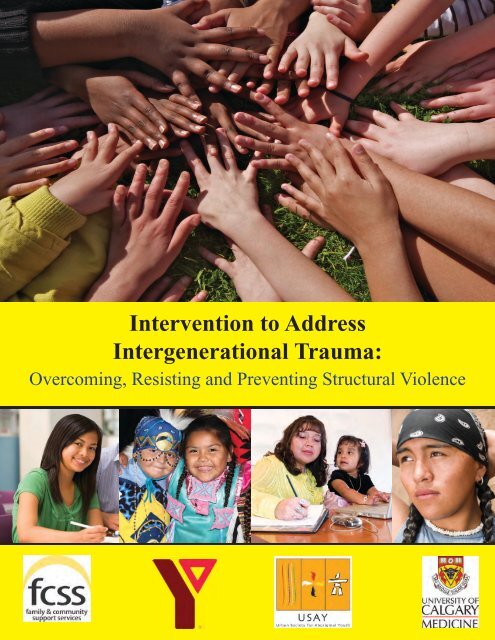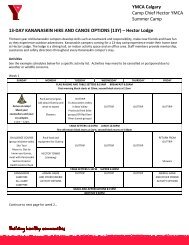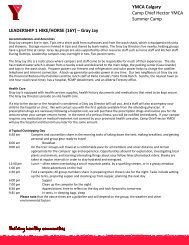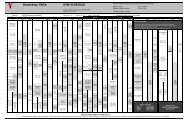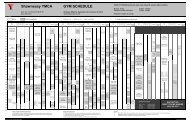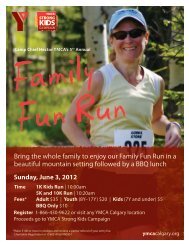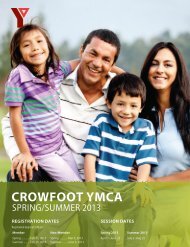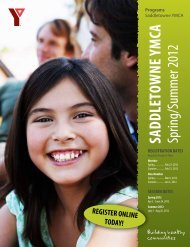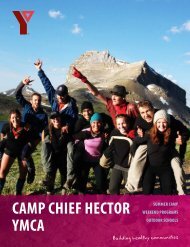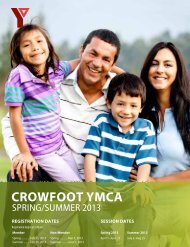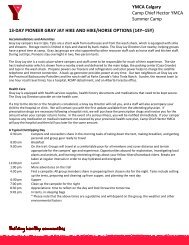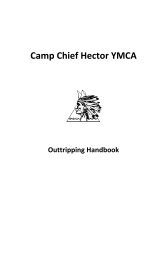Intervention to Address Intergenerational Trauma: - YMCA Calgary
Intervention to Address Intergenerational Trauma: - YMCA Calgary
Intervention to Address Intergenerational Trauma: - YMCA Calgary
- No tags were found...
You also want an ePaper? Increase the reach of your titles
YUMPU automatically turns print PDFs into web optimized ePapers that Google loves.
<strong>Intervention</strong> <strong>to</strong> <strong>Address</strong><strong>Intergenerational</strong> <strong>Trauma</strong>:Overcoming, Resisting and Preventing Structural Violence
Winter, 2012[INTERGENERATIONAL TRAUMA]ACKNOWLEDGEMENTSThis scoping review was a product of collaboration and partnership between theUrban Society for Aboriginal Youth, <strong>YMCA</strong> <strong>Calgary</strong> and University of <strong>Calgary</strong>, withfunding provided by the City of <strong>Calgary</strong>, Family and Community Support Services.We would like <strong>to</strong> acknowledge the following key stakeholders for their contribution<strong>to</strong> the project: Raheem Noormohamed, Research Assistant LeeAnne Ireland, Executive Direc<strong>to</strong>r, Urban Society for Aboriginal Youth Sharon Goulet, Community Planner, Family and Community Support Services Tanis Cochrane, VP Children and Youth Strategy, <strong>YMCA</strong> <strong>Calgary</strong> Christy Daniels, General Manager, <strong>YMCA</strong> <strong>Calgary</strong> Laurie Beatt, Outcomes Coordina<strong>to</strong>r, <strong>YMCA</strong> <strong>Calgary</strong> Wilfreda E. Thurs<strong>to</strong>n, PhD, Department of Community Health Sciences,Faculty of Medicine, University of <strong>Calgary</strong> Amrita Roy, MD-PhD student, Department of Community Health Sciences,Faculty of Medicine, University of <strong>Calgary</strong> David Turner, Research Coordina<strong>to</strong>r, NEAHR-Southern Alberta, University of<strong>Calgary</strong> Christy Morgan, Community Event Planner1
Winter, 2012[INTERGENERATIONAL TRAUMA]EXECUTIVE SUMMARYThis report discusses practices for healing the effects of intergenerational trauma inAboriginal youth. <strong>Intergenerational</strong> trauma is the transmission of his<strong>to</strong>ricaloppression and its negative consequences across generations. There is evidence ofthe impact of intergenerational trauma on the health and well-being and on thehealth and social disparities facing Aboriginal peoples in Canada and othercountries. The effects on children of survivors of the residential school system aredocumented, but it is unclear whether there exist specific practices which effectivelyfacilitate healing for intergenerational trauma in youth specifically.The Aboriginal HealingFoundation in Canadareleased a report in 2006entitled “Promising HealingPractices.” This reportdocuments a holisticframework for facilitatinghealing for intergenerationaltrauma and also delineatescategories of usefulinterventions.Theframework and thecategories are helpful inunderstanding promisingpractices in this context.This paper describes a scoping review, (see Appendix E for more details) conducted<strong>to</strong> address the question of what defines best practice for addressing the impacts onhealth of intergenerational trauma in Aboriginal youth in Canada. The purpose was<strong>to</strong> identify recommendations for practices that can address intergenerationaltrauma in Aboriginal youth, <strong>to</strong> identify areas where more research is required <strong>to</strong>learn more about what may work, and <strong>to</strong> hear from community members whatcould be of greatest benefit <strong>to</strong> Aboriginal youth who are affected byintergenerational trauma.Our scoping review consisted of sixteen papers or reports, describing practicesrelated <strong>to</strong> intergenerational trauma. The papers were analyzed and sorted based onthe health issue addressed, the Aboriginal Healing Foundation intervention type,and the recommendations provided. The recommendations and research gapsdiscovered in this process were presented <strong>to</strong> community members in December of2011. Facilitated discussions followed the presentation and the general themes fromthe discussions were compared <strong>to</strong> the recommendations and themes from theacademic process.3
[INTERGENERATIONAL TRAUMA] Winter, 2012<strong>Intergenerational</strong> trauma can seem complicated and academics have developedsophisticated modes <strong>to</strong> explain how it works. However there has been less of aneffort <strong>to</strong> develop models of healing intergenerational trauma. It is acknowledgedthat the cumulative effects of trauma are passed down along generations and oftenare amplified or cause other unpredictable impacts.With this in mind it can be unders<strong>to</strong>od why the residential school experience couldhave traumatic effects in the lives of children and grandchildren of Survivors. Inaddition, the effects of oppression and trauma on individuals can result inmaladaptive parenting that can cause challenges for children (BraveHeart, 2003).Ongoing attitudes of bigotry or discrimination <strong>to</strong>wards Aboriginals, including at apolicy or government level can amplify the existing effects of intergenerationaltrauma. (Wesley-Esquimaux and Smolewski, 2004; BraveHeart, 2003; Whitbeck etal., 2004; Sotero 2006). Aboriginal people have unique his<strong>to</strong>ries and have haddifferent aspects of trauma affect their lives, so it is not certain how prevalentintergenerational trauma is, but it is certainly a fac<strong>to</strong>r that affects the lives of asignificant number of young Aboriginal people in Canada.Negative outcomes of intergenerational trauma in Aboriginal peoples have beenidentified. For instance, establishing links between cultural discontinuity and mentalhealth and violence in First Nations groups in Canada (Kirmayer et al., 2000). Theresponse between his<strong>to</strong>ric trauma and substance abuse has been establishedthrough evidence that relatives oftrauma Survivors developsymp<strong>to</strong>ms of Post-<strong>Trauma</strong>ticStress Disorder and may abusesubstances (BraveHeart, 2003).<strong>Intergenerational</strong> trauma, culturalalienation and ongoing depressionwere found among a sample ofhomeless Aboriginal men(Menzies, 1999). In youth, ideas ofhopelessness coming fromcultural alienation from parentswere seen as a fac<strong>to</strong>r contributing<strong>to</strong> suicide (Strickland et al., 2006).“It is acknowledged that the cumulativeeffects of trauma are passed down alonggenerations and often are amplified orcause other unpredictable impacts. Ongoingattitudes of bigotry or discrimination<strong>to</strong>wards Aboriginals, including at a policy orgovernment level, can intensify the existingeffects of intergenerational trauma.”In addition, studies have linked Hepatitis C and HIV/AIDS in youth <strong>to</strong> his<strong>to</strong>ricaltrauma and experiences of sexual abuse (Pearce et al., 2008; Craib et al., 2009). On alarger scale, health statistics of Aboriginal youth in Canada show many challenges aswell (Cook and Guimond, 2008; Latimer and Foss, 2004; Chouinard et al., 2010;Health Canada, 2009). Research and advocacy by multiple researchers andstakeholders have increased awareness of the impact and intergenerationalconsequences of the residential school experience (among other events and policies)on Aboriginal communities, and have linked these ideas <strong>to</strong> a range of healthconsequences (AHF, 2006).6
Winter, 2012[INTERGENERATIONAL TRAUMA]To understand healing in a Canadian Aboriginal context, a definition for healingprovided by the Royal Commission on Aboriginal Peoples, states that Healing is:“Personal and societal recovery from the lasting effects ofoppression and systemic racism experienced over generations.Many Aboriginal people are suffering not simply from specificdiseases and social problems, but also from a depression of spiritresulting from 200 or more years of damage <strong>to</strong> their cultures,languages, identities and self-respect. The idea of healing suggeststhat <strong>to</strong> reach “whole health,” Aboriginal people must confront thecrippling injuries of the past.”7
[INTERGENERATIONAL TRAUMA] Winter, 2012ABORIGINAL HEALING FOUNDATION AND “PROMISING HEALINGPRACTICES”The Aboriginal Healing Foundation was set-up 1998 as part of the broader healingeffort for Survivors of the Residential School System and their descendants. Itsmission is:“To provide resources which will promote reconciliation andencourage and support Aboriginal people and their communitiesin building and reinforcing sustainable healing processes thataddress the legacy of physical, sexual, mental, cultural, andspiritual abuses in the residential school system, includingintergenerational impacts.”Their work is very relevant, and we used many of their <strong>to</strong>ols and ideas as afoundation for our research. In 2006 they released a report entitled, “PromisingHealing Practices.” This report introduced the idea of “Promising Healing Practices,”in place of “Best Practice”. They defined “Promising Practices” as, “Models,approaches, techniques and initiatives that are based on Aboriginal experiences;that feel right <strong>to</strong> Survivors and their families; and that result in positive changes inpeople’s lives.”(p.7)It is a more inclusive approach <strong>to</strong> healing from intergenerational trauma. TheAboriginal Healing Foundation definition will guide us in reviewing other practicesfound during the scoping review.ABORIGINAL HEALING FOUNDATION - PILLARS OF HEALINGThe Pillars of Healing as identified by the Aboriginal Healing Foundation are: Legacy Education; Cultural <strong>Intervention</strong>s; and Therapeutic <strong>Intervention</strong>s.These are categories of interventions based on the type of techniques used in theprogram and the desired goal of the program.LEGACY EDUCATIONLegacy Education seeks <strong>to</strong> raise awareness of the residential school (or othertraumatic) experiences and consequences. This is beneficial because it builds anunderstanding of shared experiences, allows responses <strong>to</strong> trauma <strong>to</strong> be seen as aresult of external forces, allows children <strong>to</strong> better understand the situation of theirparents and generally uses awareness <strong>to</strong> facilitate understanding which in turn canmotivate survivors and youth <strong>to</strong> pursue healing. It often involves just teaching youthabout the past.8
Winter, 2012[INTERGENERATIONAL TRAUMA]CULTURAL INTERVENTIONSCultural interventions work by infusing cultural awareness and teaching as theprimary goal of interventions. Cultural activities are the keys<strong>to</strong>ne of theseinterventions. This category can include any type of cultural activity beyond alreadyrecognized healing ceremonies as an intervention. These interventions are meant <strong>to</strong>mold and reinforce identity, so as <strong>to</strong> facilitate the healing process.THERAPEUTIC INTERVENTIONSThese deal directly with a specific outcome such as a health issue. The AboriginalHealing Foundation report mentionswestern, traditional, and combinedtherapeutic approaches in thiscategory. Western approachesgenerally favor medical models ofdisease that look at the individuallevel and act <strong>to</strong> alleviate sufferingthrough physical means, althoughother forms of social work are part ofthis category. Traditional therapies aregenerally more holistic and view theindividual as a part of culture and theenvironment. These therapeuticapproaches are rooted in Aboriginalworldviews and have many possiblevariations. Approaches may includetraditional practices, such as sweat lodges, pipe ceremonies or healing circles.Combined therapies attempt <strong>to</strong> effectively integrate Western and traditionalapproaches <strong>to</strong> healing by using traditional components in medical therapies or usingWestern models in a traditional setting.SCOPING REVIEW RESULTSIn an ideal situation, these interventions would all be available <strong>to</strong> youth in the orderlisted above. Since many programs might only fit one category, the scoping reviewpapers were sorted according <strong>to</strong> the category they best fit.INTERVENTION RESULTSOverall, the results of the various interventions are as follows: 1 practice fit under the label of Legacy Education; 4 were Cultural <strong>Intervention</strong>s; 10 were Therapeutic <strong>Intervention</strong>s; and 2 were described as other because they were not easily identifiable in any ofthese categories, but they did attempt <strong>to</strong> address an outcome related <strong>to</strong>intergenerational trauma in Aboriginal Youth.9
Winter, 2012[INTERGENERATIONAL TRAUMA]Another promising combined therapeutic intervention involved the use of theCognitive Behavioral <strong>Intervention</strong> for <strong>Trauma</strong> in Schools (CBITS). This interventionwas modified for use in an American Indian community and was found by theauthors <strong>to</strong> be best practice for addressing Post <strong>Trauma</strong>tic Stress Disorder anddepressive symp<strong>to</strong>ms for ethnically diverse youth. It was modified by reframingsome of the sessions used in the interventions around <strong>to</strong>pics of his<strong>to</strong>rical injustice,traditional his<strong>to</strong>ry and coping through identification with their community. Parentswere also involved in the intervention. While this example was somewhat Western,the authors explicitly aimed <strong>to</strong> address Post <strong>Trauma</strong>tic Stress Disorder from anAmerican Indian context and wanted the intervention <strong>to</strong> be seen as a syntheticprocess (Goodkind et al., 2010). Other Western and Traditional therapeutic practicesseemed promising; however, it is combined approaches that were most common inthe scoping review.11
[INTERGENERATIONAL TRAUMA] Winter, 2012RECOMMENDATIONS FROM THE SCOPING REVIEWRecommendations made by each author were collected and compared. There were fourcommon recommendations:RECOMMENDATION #1 - INTEGRATING ABORIGINAL WORLDVIEWS OR “CULTURE” INTO EFFORTS TOADDRESS INTERGENERATIONAL TRAUMA IN YOUTHSix papers recommended that Aboriginal worldviews and ideas of holistic interventionsthat integrate community and culture must be a part of any intervention. Some of thepractices that were cultural interventions, such as those using excursions with Elders <strong>to</strong>learn more about traditional ways of life, were entirely built around Aboriginalworldviews. However, other papers explained that when they used an interventionmethod that may have been less traditional, ideas of holism and inter-connectedness <strong>to</strong>community and family were emphasized in the intervention. For example, certain reportsclaimed that promoting self-reliance and personal empowerment are part of Aboriginalideas of healing and must therefore fit in<strong>to</strong> the intervention. One author brought up theidea of “Cultural Relevance,” as important for those interventions that borrow heavilyfrom Western or other practices. This may or may not count as using an Aboriginalworldview in a program, but at least one author felt that it did.Aboriginal worldviews are diverse and no simple explanation of what they are exists.They may depend on geography, his<strong>to</strong>ry, culture and much more, but it can be said thatthey do represent another element <strong>to</strong> consider when discussing healing. Since theAboriginal Healing Foundation chose <strong>to</strong> outline this same concept as important <strong>to</strong> healinginitiatives, their ideas of Aboriginal worldviews and values could further ourunderstanding. The Aboriginal Healing Foundation (2006) describes important values <strong>to</strong>consider in healing initiatives as, “Values of wholeness, balance, harmony, relationship,connection <strong>to</strong> the land and environment, and a view of healing as a process and lifelongjourney” (p. 34).RECOMMENDATION #2 - USING THE FORMATION OF CULTURAL IDENTITY AS A HEALING TOOLStrengthening cultural identity can help facilitate the healing process. Youth positiveidentity can reduce the stigma of some issues or allow youth <strong>to</strong> feel re-connected <strong>to</strong> theirculture from which the may feel removed (Aho and Liu, 2010). In the recommendationsmade by papers, identity was seen as a <strong>to</strong>ol for building self-reliance and encouragingpolitical engagement. According <strong>to</strong> some authors, identity must be framed as a dynamicpersonal commitment <strong>to</strong> tradition that takes in<strong>to</strong> account circumstances of the present andthe past. Other findings reveal that youth well-being in response <strong>to</strong> intergenerationaltrauma can be facilitated by empowering cultural identities (Taylor and Usborne, 2010).Also, cultural continuity combined with community empowerment initiatives, has beenfound <strong>to</strong> be a protective fac<strong>to</strong>r against suicide in Aboriginal youth (Chandler andLalonde, 2008).12
Winter, 2012[INTERGENERATIONAL TRAUMA]RECOMMENDATION # 3 - PROMOTING ABORIGINAL YOUTH GROUPS AND ORGANIZATIONS THAT DEALWITH INTERGENERATIONAL TRAUMA TO BE AUTONOMOUSTwo papers identified the need for youth groups <strong>to</strong> be agents of political advocacy. Youthgroups have the ability <strong>to</strong> build resiliency and empower youth <strong>to</strong> combat ongoingdiscrimination and <strong>to</strong> advocate for more necessary attention and resources fromgovernment and others. Self-determining youth groups often could best identify needs forother in the communities who may be affected by intergenerational trauma (Shantz,2010). This theme of au<strong>to</strong>nomy is also recommended by others who believe that withoutit other institutions or agencies that serve Aboriginal youth can prevent the use of culturalideas of healing in programs (Smith et al., 2005; AHF, 2006).RECOMMENDATION #4 - INTEGRATING ONGOING PROGRAMS WITH MAINSTREAM HEALTH SERVICESAND FURTHERING OVERALL COLLABORATIONCollaboration and connections with other health or social services would allow forgreater access <strong>to</strong> funding, treatment, or research capacity, especially in more rural, remoteareas. It was also emphasized that mainstream health agencies and staff must learn moreabout Aboriginal worldviews and ways of healing. Additionally, there needs <strong>to</strong> be greaterknowledge of intergenerational trauma among workers. Some authors recommended thattheir specific intervention be adopted (but modified if necessary) by larger healthagencies or government bodies, in order <strong>to</strong> serve large communities.One example of collaboration was on a project that sought <strong>to</strong> deal with rehabilitation forAboriginal youth who had committed crimes. A group of University faculty teamed upwith existing youth-serving agencies <strong>to</strong> profile and <strong>to</strong> evaluate what work was beingcarried out (Lafreniere, 2006).Collaboration with mainstream health services should not interfere with organizationau<strong>to</strong>nomy and, it is important <strong>to</strong> note that there should be a balance between them.13
[INTERGENERATIONAL TRAUMA] Winter, 2012COMMUNITY DISCUSSIONThe questions posed <strong>to</strong> community members after the presentation of the academicfindings were: Of the recommendations that were discussed <strong>to</strong>day, do you have similar practicesin your agency’s programs? (Please see last section for recommendations). How do you know what you do is effective in addressing intergenerationaltrauma? What would your agency need <strong>to</strong> better implement and evaluate your youthprogramming?Analysis of the discussion group conversations showed some common themes that arepresented on the following pages. Appendix C lists a table of common themes.THEME #1 - PRACTICES OR PROGRAMS THAT INCORPORATE OR USE ABORIGINAL WORLDVIEWS INSOME WAY IN ADDITION TO ATTEMPTS TO STRENGTHEN YOUTH IDENTITYConversations revolved aroundthe first and secondrecommendations, wherecommunity members often feltthat their programs, includingthose that may not haveaddressed intergenerationaltrauma explicitly, includedsome element of Aboriginalvalues or culture or wereholistic. Program participantsview the programs as placeswhere cultural identity isexplored and strengthened.The idea of incorporatingAboriginal worldviews meansmany things, but examplesincluded using traditionalactivities for healing purposes,involving families inprograms, incorporatinghis<strong>to</strong>ry in<strong>to</strong> programs, andusing holistic language.One Aboriginal participantexplained their approach in aspecific program:14
Winter, 2012[INTERGENERATIONAL TRAUMA]“[Our program] focuses on Aboriginal learning styles, specific <strong>to</strong> theirneeds in learning. How do we help them reconnect <strong>to</strong> their culturewhich was a huge issue for many of them and so we look at each ofthe barriers that were preventing them from engaging in the successesin education and employment and then tried <strong>to</strong> use research-basedinformation for curriculum development that was specific <strong>to</strong>Aboriginal learning styles.”The discussions reflected the academic theme of incorporating cultural elements in<strong>to</strong>programs. This overlapped with the idea discussed by some respondents about havingstaff trained in Aboriginal awareness or hiring Aboriginal staff. Some responses outlinedthat staff had undergone competency training <strong>to</strong> work with Aboriginal people invulnerable settings while others stressed the importance of hiring Aboriginal staff <strong>to</strong> workwith youth. This broadly related <strong>to</strong> the academic recommendation of having mainstreamprofessionals be trained further in the his<strong>to</strong>ry and values of the people they work with andthe programs and services they deliver.THEME #2 - COLLABORATIONS OR CONNECTIONS TO OTHER GROUPS OCCURS IN PROGRAMS FOR AVARIETY OF REASONSThe other common recommendation shared by community members was collaboration.The general theme of working with other partners, whether by other youth agencies,government or academics, was discussed by some groups. The purposes of collaborationcertainly varies; some community members spoke of it as a means <strong>to</strong> learn more aboutAboriginal youth, while others talked about it for research purposes.THEME #3 - ORAL FEEDBACK OR SIMILAR FORMS OF REFLECTION AND NARRATIVE FORMATION AREA KEY PART OF PROGRAM EVALUATIONSTalk of assessment generated many diverse responses and all types of relaxed or informaltypes of evaluation were brought up as well as more research-oriented methods. Oralfeedback from participants was the most common form of evaluation. This meant thatconversations, interviews, s<strong>to</strong>ries or other methods of assessment were important. Thenotion that conversations are practical for evaluation was seen <strong>to</strong> be valid by some onlywhen there was a safe, trusting environment.One respondent stated:“The students feel safe when they come <strong>to</strong> our center. That’s how Iknow we’re doing a good job when they feel that they’re comfortable<strong>to</strong> say what they need <strong>to</strong> say whether they have a criticism of what’shappening at the Lodge or whether they have something very heavyon their hearts; it’s safe for them <strong>to</strong> share it.”Oral feedback can also be combined with other measures of success. This responseillustrates this concept:15
[INTERGENERATIONAL TRAUMA] Winter, 2012“Every morning [the youth] have a sharing circle and, [we ask] howwas your night, what went on, say for example one of the youth had afight with their Mom or their boyfriend; you know then they’re askedwell how did you address it, how did you deal with it, did you applyyour life skills in that situation right and so they’re asked those typesof questions and the youth are pretty honest.”THEME #4 - COMMITMENT TO PROGRAMS OR UPKEEP OF ATTENDANCE BY YOUTH AS WELL ASPROGRAM GROWTH IS INDICATORS OF SUCCESSMany respondents outlined that they felt ongoing participation and/or completion ofprograms indicated success. This generally meant that because the program was having apositive effect in the life of a youth, he or she was compelled <strong>to</strong> return and be an activeparticipant. Also, the idea that the program was growing in size, in that more youth wereattending, was seen as a positive outcome in terms of a quantitative evaluation.THEME #5 - SURVEYS, QUESTIONNAIRES OR STRICT MEASUREMENTS CAN BE USED FOR ASSESSMENTSome, but not many, community members outlined the use of studies and/or surveys inprograms. Not many specific details about these measures were uncovered, but it wasimportant <strong>to</strong> note their presence. Responses also emerged that outlined the involvemen<strong>to</strong>f family in assessments, including with surveys. As one participant outlined:“We also do a risk provider survey at the end of service...there is onequestion about do we serve needs of families and that’s really the waywe approach our work with any families - looking at what are theirunique needs.”THEME #6 - CONSISTENT AND APPROPRIATE FUNDING REMAINS A BARRIER TO FURTHERIMPLEMENTATION AND EVALUATION OF YOUTH PROGRAMSThe third question <strong>to</strong>uched on what was needed moving forward. The question exploredbarriers <strong>to</strong> progress in promising youth practices and also how <strong>to</strong> better measure thisprogress. A single theme emerged from all the groups; funding was a barrier. Thisincludes a lack of funding for successful programs, unreliable or inconsistent funding,funding that is not individualized <strong>to</strong> the needs of youth and the inability of funders andthe government <strong>to</strong> fully comprehend the situation they are funding as well as how theycan contribute funds in ways that actually reflect the desire and needs of communities.Since funding was the most common response, then it may be the primary obstacle <strong>to</strong>more programs for healing intergenerational trauma. A desire for more flexible,appropriate funding that takes in<strong>to</strong> account more holistic needs was expressed by some.One community member explained,“Of course, funding is important and we’re always chasing thatbecause we realize all of our cultural programs... exhausts funding sowe have <strong>to</strong> go out every year and try <strong>to</strong> get that money, but I thinkeven more importantly is having the buy in institutionally...that helps16
Winter, 2012[INTERGENERATIONAL TRAUMA]direct the vision of the work and the approach [of the funder] and thatit is respectful and empowering, for all.”In general these words reflect the funding issue quite well,“I think in our facility especially it comes down <strong>to</strong> the dollar. Youcan’t bring in a lot of things because of funding and we’re allottedcertain amounts and just like, this one program that we had lastweek...it was a huge success, but will that ever come back? Mostlikely not, just because of the dollar.”THEME #7 - COLLABORATIONS AND ESTABLISHING PARTNERSHIPS BETWEEN AGENCIES AND OTHERSCollaboration related <strong>to</strong> all three questions. It came up as a recommendation in the firstquestion and was seen as a necessity in the third question for evaluation. Simply put, onecommunity member remarked,“Connection, connection <strong>to</strong> the community, connection <strong>to</strong> the peoplearound, connections with people that sit at this table...I think thegreater numbers of people that are working, [know] better...buildingand building and creating relationships, true relationships with thecommunity.”Two other themes that arose were the involvement of families and access <strong>to</strong> Aboriginalstaff. Family involvement was described as absent by some community members. Theyfelt that by attempting <strong>to</strong> heal families facing trauma, positive effects could be felt byyouth as well. The idea of using Aboriginal staff was echoed in the first question andmeant that facilitation of cultural traditions can only really be done well by Aboriginalstaff. An alternative explanation was that for youth <strong>to</strong> feel comfortable in a programAboriginal staff or men<strong>to</strong>rs should be present.THEME #8 - MORE AWARENESS AROUND INTERGENERATIONAL TRAUMA AND HOW TO HEAL IT INYOUTH ARE NECESSARY.One general theme that came up across was the notion that intergenerational trauma wasnot explicitly addressed by programs. This meant that in the first question somecommunity members said that their youth programs did not address it in any way and forthe second question it meant it was not assessed. For the third question this meant thateither participants might not see addressing intergenerational trauma as a primaryobjective, but more commonly it meant that they wanted <strong>to</strong> know more about the effectsof intergenerational trauma and how <strong>to</strong> heal it in youth. The idea of expanding resources<strong>to</strong> address or educate about intergenerational trauma, can be summed up in this quote:“This intergenerational trauma, where somebody was <strong>to</strong> say, here’s acurriculum… this technique…. this works well; we know it workswell with this population and this situation. That would be super youknow so that’s what we would like more of.”17
[INTERGENERATIONAL TRAUMA] Winter, 2012DISCUSSIONThe themes discussed above show that some ideas for dealing with intergenerationaltrauma are unders<strong>to</strong>od by multiple agencies and groups. However, there is somedisconnect between the response <strong>to</strong> the questions, especially the second and thirdquestions, and the findings of the scoping review.INCORPORATING ABORIGINAL WORLDVIEWS OR VALUES IN PRACTICES FOR YOUTH IS A WELL-ESTABLISHED CONCEPTThe most common theme fits well with the recommendation and Aboriginal HealingFoundation idea. Integrating Aboriginal Worldviews was reflected by many communitymembers. One community member, speaking of combining Aboriginal traditionalperspectives with ongoing services, summarizes this well:“Using the <strong>to</strong>ols of what we already know as Aboriginal people andsay yes there was that Western world view but now we’re going <strong>to</strong>look at the Aboriginal world view, the traditional world views of allour people and say let’s put that <strong>to</strong> work, combine the two at somelevel and... maybe policy makers and people of authority wouldslowly turn their head and say you know what, maybe we need <strong>to</strong>change the way we do business.”COLLABORATION HAS MULTIPLE BENEFITS, BUT AWARENESS OF ABORIGINAL HISTORY ANDWORLDVIEWS MUST BE MAINTAINEDOther responses discussed the importance of cultural identity, discussed the importance ofcollaboration between researchers, youth-serving agencies and government. One examplewas the use of Master’s ofSocial Work students <strong>to</strong> helpwith assessments. Otherexamples involved workingwith Community Elders orrepresentatives <strong>to</strong> designprograms. There is noprescribed way <strong>to</strong>“collaborate”, but its presencein community programs and in“There is no prescribed way <strong>to</strong>“collaborate”, but its presence incommunity programs and in the academicrecommendations adds values <strong>to</strong> it as apotential guideline for youth programs.”the academic recommendations adds value <strong>to</strong> it as a potential guideline for youthprograms. This can be work with universities, communities or new funders. In thescoping review, some papers highlighted that individuals or groups working withAboriginal youth should be more aware of the his<strong>to</strong>ry, culture and language of the youththey engage with. The use of Aboriginal staff in some healing capacity was morecommon in discussion reports. Some participants were quite vocal about the need forAboriginal staff, yet it was absent in the academic recommendations.18
Winter, 2012[INTERGENERATIONAL TRAUMA]PROGRAM EVALUATIONCommunity discussions and the scoping review revealed that evaluations were diverse inyouth interventions. Evaluating the effects of intergenerational trauma itself can be achallenge, and neither the papers we reviewed nor the themes in the discussions put fortha way <strong>to</strong> assess if intergenerational trauma is being healed through an intervention. Thepresentation of academicfindings <strong>to</strong> communitymembers highlightedone practice found in theacademic report thatused well-known scales<strong>to</strong> measure substanceabuse, stress and selfreliancein youth, <strong>to</strong>show participants what aquantitative evaluationcould look like. Nothingsimilar, in terms ofdirect quantitativemeasurement, emergedin discussions. Instead,oral feedback remains asimple and necessaryway <strong>to</strong> conductevaluations. If this typeof conversation occursin a setting of comfort, itmay also provide a wayof receiving input abouta program from acultural perspective. When dealing with intergenerational trauma and overall health itseems like quantitative and qualitative forms of assessment do not have <strong>to</strong> compete, andpotentially may be combined for better evaluation, at least according <strong>to</strong> the AboriginalHealing Foundation (AHF, 2006).Further knowledge of intergenerational trauma would create more opportunities forpromising practices. If agencies are not <strong>to</strong>uching on this in their youth programming,there may be a need for wider education regarding this concept and its effects on wellbeing.Community responses indicated that their programs did not integrateintergenerational trauma, and they also indicated a desire <strong>to</strong> see more resources aboutintergenerational trauma and how <strong>to</strong> heal it. It may be that many healing initiatives forAboriginal youth in Canada and the other three countries reviewed, also may not takein<strong>to</strong> account intergenerational trauma in their programs. Evidence of this may be the lackof programs found that fit our research question, despite the greater number of programsavailable for Aboriginal youth, even in Canada alone (AHF, 2006).19
[INTERGENERATIONAL TRAUMA] Winter, 2012The desire for intergenerational traumaresources, including workshops,<strong>to</strong>olkits, trauma training or othereducational materials, fits with the ideathat methods of addressing his<strong>to</strong>rictrauma in Aboriginal youth are stilllacking. The fact that some discussionsidentified that his<strong>to</strong>ric trauma is not apart of programs and is not assessedmay not be the result of anunwillingness <strong>to</strong> address it but rather aresult of the lack of knowledge on how<strong>to</strong> integrate models of his<strong>to</strong>ric traumain<strong>to</strong> healing. This finding fits the ideathat public health, community or otheragencies serving Aboriginal youth incontexts where his<strong>to</strong>rical oppression ispresent should fit in models ofintergenerational trauma in<strong>to</strong> theirpractices (AHF, 2006; Sotero, 2006).Funding is interconnected with other recommendations and challenges. Academic papersreviewed said little about funding and/or resources in their reflections on theirinterventions but the need for smart, pragmatic funding is explained well by oneparticipant:“Lack of funding is overarching barrier <strong>to</strong> wider programs and moreevaluation since it is needed for more manpower, better training,greater research <strong>to</strong>ols and much more.”The source of what this funding should be varied among participants but it is certainlyrelated <strong>to</strong> some of the academic recommendations, because following them may allow forgreater ability <strong>to</strong> seek funding. This includes organizations working <strong>to</strong>gether <strong>to</strong> accessfunding and forming au<strong>to</strong>nomous politically active organizations. In terms of cooperationbetween youth-serving organizations or agencies one participant stated:“I think for funding and for manpower, it’s really difficult <strong>to</strong> get...thehelp you need, that’s why I think collaborating with other agencies isimportant… but when you work for somebody so small, <strong>to</strong> take onanother thing on my plate is almost impossible. It’s just like you needmore people <strong>to</strong> do those things but it’s impossible for funding so it’skind of like a vicious cycle that keeps going around.”This quote reveals one of the challenges of working <strong>to</strong>gether; joint initiatives themselvesbetween agencies might require resources that aren't present.20
Winter, 2012[INTERGENERATIONAL TRAUMA]Overall, it remains a challenge <strong>to</strong> say what a “promising healing practice” for addressingintergenerational trauma in Aboriginal youth. Even the recommendations from thescoping review are limited due <strong>to</strong> thefew papers available. From anacademic perspective a major findingof this academic process is that thereis little written on the question welooked at and therefore there is agood deal of room for furtherresearch. However, from theviewpoint of those working directly“Overall, it remains a challenge <strong>to</strong> saywhat a ‘promising healing practice’ is foraddressing intergenerational trauma inAboriginal youth.”with Aboriginal youth, it may be frustrating <strong>to</strong> hear that further research is a part of thisreport. There was some disconnect with the research felt by a few participants and itshould not be overlooked, instead community agencies or healing groups should beconsulted in order <strong>to</strong> better identify “Best Practice.” This model, followed by the AHF, <strong>to</strong>use community input along with investigative research <strong>to</strong> provide models of healing, issomething that could be replicated for addressing intergenerational trauma in youth. Indiscussing next steps, the needs of researchers and community groups will be addressedin regards <strong>to</strong> what steps can be taken <strong>to</strong> establishing what constitutes promising practicesand generally how <strong>to</strong> work with Aboriginal youth in Canada <strong>to</strong> heal intergenerationaltrauma and build resilience.21
[INTERGENERATIONAL TRAUMA] Winter, 2012NEXT STEPSSTEP #1 - REPORTING AND EVALUATION MUST INCREASE FOR PRACTICES INVOLVING ABORIGINALYOUTHCommunity leaders and organizations may have valuable techniques <strong>to</strong> help heal youth,but if these ideas are not shared through accessible reports then many youth may notbenefit from the techniques. This finding is valid for researchers and communitymembers alike. The scoping review was very broad, searched a wide range of potentialsources, and the result of 16 practices emerging as relevant <strong>to</strong> the search is minimal. Thiscould be that either reports or papers are not readily available or that reporting onongoing programs is minimal. The issue of having <strong>to</strong>o few papers <strong>to</strong> analyze makes ithard <strong>to</strong> recommend promising practices for healing intergenerational trauma inAboriginal youth in Canada, especially when the need is pressing (Sotero, 2006). It mayalso be likely that programs are not explaining their use of intergenerational trauma, yetthey still see its role in their work. As one participant commented:“[The Research] missed the point that unless the article or academicpaper didn’t specifically say this intervention was <strong>to</strong> addressintergenerational trauma, then it wasn’t included but so then you’re,excluding all Indigenous ceremonies, you’re excluding most programswho are dealing with intergenerational trauma because it may notknow it or specifically say this and all of those practices that arealready happening.”Reporting on intergenerational trauma and practices would make it much easier <strong>to</strong>conduct research like this in this future. One of the recommendations found in multiplepapers was <strong>to</strong> support collaboration between agencies or institutions with Aboriginalcommunities <strong>to</strong> support healing efforts and integration of these efforts in<strong>to</strong> mainstreamhealth services.22
Winter, 2012[INTERGENERATIONAL TRAUMA]STEP #2 - SEARCH FOR NEW EVALUATION METHODSEvaluation is the least standard aspect that came out of out academic report and ourdiscussions. This lack of consistency makes it very hard <strong>to</strong> say what programs aresuccessful. One of the challenges in evaluation may be finding a balance betweenWestern evaluation techniques that are rigorous and also integrating Aboriginalworldviews and ideas of what are indica<strong>to</strong>rs of success within communities (Robinsonand Tyler, 2005; AHF, 2006). The diverse Aboriginal worldviews and notions of holismthat are often unique <strong>to</strong> certain communities may rely on oral or narrative methods ofevaluation and often improved relationships <strong>to</strong> one's land, one's community and Elders orcommunity leaders will be part of a successful intervention(Robinson and Tyler, 2005;AHF, 2006). All of this is consistent with the theme of oral feedback that emerged as amajor theme in the community discussions. The next step here might be finding ways ofevaluating programs that effectively combine evaluation methods from Western,Aboriginal and other perspectives.STEP #3 - DEVELOP AND SHARE RESOURCES FOR EDUCATING OR ADDRESSING INTERGENERATIONALTRAUMA IN ABORIGINAL YOUTHBased on the consultation, more <strong>to</strong>ols specific <strong>to</strong> addressing intergenerational traumaneed <strong>to</strong> be developed. This might include the production of easy-<strong>to</strong>-read educationalmaterials or specific training developed <strong>to</strong> address trauma in youth. Greater effort has <strong>to</strong>be placed on howcommunity agencies canaccess information aboutAboriginal youth and thetrauma they may face.Both the AboriginalHealing Foundation andthe Legacy of HopeFoundation have foundways of raisingawareness of theintergenerational impactsof Residential Schools.Beyond this, it may beuseful <strong>to</strong> also haveresources that providesupport <strong>to</strong> communityorganizations or healthworkers. As more ways<strong>to</strong> address intergenerational trauma in youth are developed and implemented, it may betime for researchers and others <strong>to</strong> begin <strong>to</strong> find ways <strong>to</strong> address specific populationswithin the Aboriginal population. This means looking at Aboriginal youth in differentsettings, such as looking at Urban or Rural youth differently, or looking at the specifichis<strong>to</strong>rical experiences of a given community. Gender is also important <strong>to</strong> consider.23
[INTERGENERATIONAL TRAUMA] Winter, 2012STEP #4 - SEEK NEW WAYS OF COLLABORATION, BUILD NEW PARTNERSHIPS AND ADDRESS FUNDINGTHOUGH CONNECTIONS.New partnerships among agencies, with funders and with researchers are a theme thatcame up in the discussions; it has many benefits. These may include increased politicalinfluence, access <strong>to</strong> more funding, greater visibility of the needs of Aboriginal youth andeasier access <strong>to</strong> knowledge about healing from intergenerational trauma. Furthercollaboration and communication between existing youth-serving agencies, andgovernment, universities and others, can help determine what types of partnerships areeffective and how these partnerships can be formed and sustained.For funding, which was seen as a major barrier <strong>to</strong> progress, funders might need <strong>to</strong> bemore aware of how intergenerational trauma affects the service needs of some vulnerableAboriginal youth. Organizations applying for funding also need <strong>to</strong> be able <strong>to</strong> explain howtheir practices address intergenerational trauma and why this is important. The idea ofmore appropriate, flexible funding is also an important aspect of theme that should beexplored further. If there are clear benefits coming from ongoing activities that can beproven, then funders will be more likely <strong>to</strong> provide funding. In this regard, collaborationbetween groups, improving evaluation and increasing public knowledge ofintergenerational trauma are all themes that are tied in<strong>to</strong> funding.24
Winter, 2012[INTERGENERATIONAL TRAUMA]CONCLUSION:This research and community project emerged out of a need <strong>to</strong> look specifically at youthand the effects of the trauma of the Residential School experience as it relates <strong>to</strong> them.Significant work has occurred <strong>to</strong> heal from intergenerational trauma in Aboriginalpopulations, but there is certainly more work <strong>to</strong> be done. Developing bettercommunication between agencies and increasing reporting will be of great value. Thegoal of this project was <strong>to</strong> initiate the search for promising practices for healingintergenerational trauma in Aboriginal youth. Although many gaps in understandingwere found, the process also highlighted that it is realistic <strong>to</strong> have more concreteguidelines in the future and that community partners are certainly willing <strong>to</strong> be a part ofthis process.25
[INTERGENERATIONAL TRAUMA] Winter, 2012BIBLIOGRAPHYThose that are in bold are the sixteen papers analyzed in the scoping review.Aboriginal Healing Foundation. (2006). Final Report of the Aboriginal Healing Foundation: Volume II Measuring Progress: Program Evaluation. Ottawa: AboriginalHealing Foundation.Aboriginal Healing Foundation. (2006). Final Report of the Aboriginal Healing Foundation Volume III Promising Healing Practices in Aboriginal Communities. Ottawa:Aboriginal Healing Foundation.Aguilera, S., & Plasencia, A. V. (2005). Culturally appropriate HIV/AIDS and substance abuse prevention programs for urban native youth. Journal of PsychoactiveDrugs, 37(3), 299-304.Aho, K. L., & Liu, J. H. (2010). Indigenous suicide and colonization: The legacy of violence and the necessity of self-determination. International Journal ofConflict & Violence, 4 (1), 124-133.Brave Heart, M. Y. (2003). The his<strong>to</strong>rical trauma response among natives and its relationship with substance abuse: A lakota illustration. Journal of PsychoactiveDrugs, 35(1), 7-13.Brave Heart M.Y, & DeBruyn L. (1998). The American Indian Holocaust: Healing his<strong>to</strong>rical unresolved grief. American Indian and Alaska Native Mental HealthResearch, 8(2):56–78Chandler, M. J., Lalonde, C. E., Sokol, B. W., & Hallett, D. (2003). Personal persistence, identity development, and suicide: A study of native and non-native NorthAmerican adolescents. Monographs of the Society for Research in Child Development, 68(2), vii-130.Chouinard, J.A., Moreau, K., Parris, S., & Cousins, J. B. (2010). Special study of the National Aboriginal Youth Suicide Prevention strategy. Ottawa: Centre for Researchon Evaluation and Community Services, University of Ottawa.Craib, K. J., Spittal, P. M, Patel ,S. H, et al. (2009) Prevalence and incidence of hepatitis C virus infection among Aboriginal young people who use drugs:results from the Cedar Project. Open Medicine, 3, 220.DeGagne, M. (2007). Toward an aboriginal paradigm of healing: <strong>Address</strong>ing the legacy of residential schools. Australasian Psychiatry, 15(Suppl 1), S49-53.Dell, D., et al. (2011). From benzos <strong>to</strong> berries: Treatment offered at an aboriginal youth solvent abuse treatment centre relays the importance of culture.Canadian Journal of Psychiatry -Revue Canadienne De Psychiatrie, 56(2), 75-83Evans-Campbell, T. (2008). His<strong>to</strong>rical trauma in American Indian/Native Alaska communities: A multilevel framework for exploring impacts on individuals, families,and communities. Journal of Interpersonal Violence, 23(3), 316-338.Freedenthal, S. & Stiffman A. (2004). Suicidal behavior in urban American Indian adolescents: A comparison with reservation youth in a southwestern state. Suicide& Life-Threatening Behavior, 34(2), 160-171.Gilder, D. A., Luna, J. A., Calac, D., Moore, R. S., Monti, P. M., & Ehlers, C. L. (2010). Acceptability of the use of motivational interviewing <strong>to</strong> reduce underagedrinking in a Native American community. Substance use & Misuse, 46(6), 836-842.Goodkind, J. R., Lanoue, M. D., & Milford, J. (2010). Adaptation and implementation of cognitive behavioral intervention for trauma in schools with AmericanIndian youth. Journal of Clinical Child & Adolescent Psychology, 39(6), 858-872.Guimond, E., & Cooke, M. (2008). The Current Well-Being of Registered Indian Youth: Concerns for the Future? Horizons, 10(1), 26-30.Hallett, D., Chandler, M. J., & Lalonde, C. E. (2007). Aboriginal language knowledge and youth suicide. Cognitive Development, 22(3), 392-399.Health Canada. (2009). A Statistical Profile on the Health of First Nations in Canada: Self-rated Health and Selected Conditions, 2002 <strong>to</strong> 2005. Ottawa: First Nationsand Inuit Health Branch.Higgins, D.J. (ed.). (2005). Indigenous community development projects: Early learnings research report. Vol. 2. Melbourne: Telstra Foundation.Hodge, D. R., Limb, G. E., & Cross, T. L. (2009). Moving from colonization <strong>to</strong>ward balance and harmony: A native american perspective on wellness. SocialWork, 54(3), 211-219.Holland, P., Gorey, K. M., & Lindsay, A. (2004). Prevention of mental health andbehavior problems among sexually abused aboriginal children in care. Child & Adolescent Social Work Journal, 21(2), 109-115.Kirmayer L. J., Brass G. M., & Tait C. L. (2000) The mental health of Aboriginal peoples: Transformations of identity and community. Canadian Journal of Psychiatry,45(7), 607-616Kye,W (2002).E.L.D.E.R.S Gathering for Native American Youth: Continuing Native American Traditions and Curbing Substance Abuse in Native American Youth.Journal of Sociology and Social Welfare, 29(1): 117-135Lafreniere, G., Diallo, P. L., Dubie, D., & Henry, L. (2005). Can university/community collaboration create spaces for Aboriginal reconciliation? Case study of thehealing of the seven generations and four directions community projects and Wilfrid Laurier University. The First Peoples Child & Family Review, 2(1),53-66.Latimer, J., & Foss, L. (2004). A One-Day Snapshot of Aboriginal Youth in Cus<strong>to</strong>dy Across Canada: Phase II. Ottawa: Department of Justice Canada.Lowe, J. (2002). Balance and Harmony Through Connectedness: The Intentionality of Native American Nurses. Holistic Nursing Practice, 16(4), 4-11.Lowe, J. (2006). Teen intervention project--cherokee (TIP-C). Pediatric Nursing, 32(5), 495-500.Marlatt, G. A., Larimer, M., Mail, P. D., Hawkins, E. H., Cummins, L. H., Blume, A. W., et al. (2003). Journeys of the circle: A culturally con- gruent life skillsintervention for adolescent Indian drinking. Alcoholism: Clinical & Experimental Research, 27, 1327-1329Menzies, P. (2006). <strong>Intergenerational</strong> trauma and homeless aboriginal men. Canadian Review of Social Policy, (58), 1-24.National Aboriginal Health Organization. (2008). Cultural Competency and Safety: A Guide for Health Care Administra<strong>to</strong>rs, Providers and Educa<strong>to</strong>rs. Ottawa:National Aboriginal Health Organization.Palmer D., Watson J., Watson A., Ljubic, P., Wallace-Smith H., & Johnson M. (2006). Going back <strong>to</strong> country with bosses: the Yiriman Project, Youth Participationand Walking along with Elders. Children, Youth and Environments, 16(2), 317-337.Pearce, M. E., Christian, W. M., Patterson, K., Norris, K., Moniruzzaman, A., et al. (2008). The cedar project: His<strong>to</strong>rical trauma, sexual abuse and HIV risk amongyoung aboriginal people who use injection and non-injection drugs in two canadian cities. Social Science & Medicine, 66(11), 2185-2194.Quinn, A. (2007). Reflections on intergenerational trauma: Healing as a critical intervention. First Peoples Child & Family Review, 3, 722.Robinson, G. & Tyler, B. (2006) Ngaripirliga'ajirri - An early intervention program on the Tiwi Islands: Final Evaluation Report. Casuarina, Australia: School for Socialand Policy Research, Charles Darwin UniversityShantz, J. (2010). The foundation of our community': Cultural res<strong>to</strong>ration, reclaiming children and youth in an indigenous community. The Journal of SocialWelfare & Family Law, 32(3), 229-236.Sotero, M.(2006). A conceptual model of his<strong>to</strong>rical trauma: Implications for public health practice and research. Journal of Health Disparities Research and Practice,1 (1), 93–108.Smith, D., Varcoe, C., & Edwards, N. (2005). Turning around the intergenerational impact of residential schools on aboriginal people: Implications for health policyand practice. Canadian Journal of Nursing Research, 37(4), 38-60.Struthers, R., & Lowe, J. (2003). Nursing in the native american culture and his<strong>to</strong>rical trauma. Issues in Mental Health Nursing, 24(3), 257-272.·Tsey, K., Whiteside, M., Haswell-Elkins, M., Bainbridge, R., Cadet-James, Y., & Wilson, A. (2010). Empowerment and indigenous australian health: A synthesis offindings from family wellbeing formative research. Health & Social Care in the Community, 18(2), 169-179.Usborne, D.M. & Taylor, E. (2010). When I Know Who ?eAre, I Can Be ?e The Primary Role of Cultural Identity Clarity for Psychological Well-Being. TransculturalPsychiatry, 47(1), 93-111.Wesley-Esquimaux, C. and Smolewski, M. (2004). His<strong>to</strong>ric <strong>Trauma</strong> and Aboriginal Healing. Ottawa: Aboriginal Healing Foundation.Wexler, L. M. (2006). Inupiat youth suicide and culture loss: Changing community conversations for prevention. Social Science & Medicine, 63(11), 2938-2948.Veroff, S. (2002). Participa<strong>to</strong>ry art research: Transcending barriers and creating knowledge and connection with young Inuit adults. American BehavioralScientist, 45(8), 1273-1287.26
Appendix ALiterature Review Result Tables1.Papers sorted by AHF intervention category(16 papers)Legacy Education 1Cultural <strong>Intervention</strong>s 4Traditional Therapeutic 2Western Therapeutic 3Combined Therapeutic 5Alternative Therapeutic 0Other 22.Papers sorted by illness/condition addressed(16 papers)Substance Use/Alcohol Use 7Suicide 4PTSD/trauma recovery 1Sexual Abuse prevention/recovery 1Depression/mental health 1Diet/Diabetes 1HIV/AIDS 1Offender Rehabilitation 1General personal well-being/culture 1Appendix BResults from consultation and focus-group discussions, 6 groups in <strong>to</strong>talQuestion 1:Of the recommendations that were discussed <strong>to</strong>day, do you have similar practices in your agencies programs?General Theme in Discussion Number of Groups Articulating Theme Main Idea of ThemeAboriginal worldviews are holisticallyintegrated in<strong>to</strong> programmingCultural programming used <strong>to</strong> build asense of identityStaff are trained/aware of specificcontexts they are working(ie. They are4 • participants articulated inmany ways that this was therecommendation that was mostfamiliar with them• stressed the importance ofbeing holistic in specificapproaches and understandingcultural notions of well-beingin youth3 • responses stated thattraditional and/or culturallyrelavent activities <strong>to</strong> the youthwere used• most participants stating thisdid estabish a link betweenthese cultural practices andyouth identity.3 • primarily expressed that staffor healers were often
skilled healers)Programming is connected orcollaborates with other local health orsocial servicesYouth programs do not deal withintergenerational trauma in anycapacitythemselves Aboriginal and thiswas felt <strong>to</strong> provide a morecomfortable healingenvironment• some programs discussedinvolved men<strong>to</strong>rship as a <strong>to</strong>ol2 • partnerships between health,government or youth agencieswas reflected in the groups bystatements that referred <strong>to</strong>existing partnershipsorganizations• benefits of this includingfunding and/or researchcapability were discussed aswell.2 • this theme did not necessarilyfit in with therecommendations but wasimportant because it showedthat agencies may feel thatthey need <strong>to</strong> expand onaddressing intergenerationaltrauma before they canconsider otherrecommendations.Question 2: How do you know what you do works in addressing intergenerational trauma?General Theme in Discussion Number of Groups Articulating Theme Main Idea of ThemeOral feedback and reflection fromparticipants can indicated successAttendance and participation inprograms as well as growth of theprogram shows success5 • notions of using directinterviews, narratives orinformal discussions as <strong>to</strong>olsof gauging how effectiveprograms may be came up• subjective, verbal assessmen<strong>to</strong>f a program by a youthparticipant could often be thebest marker of change in thatyouth• some participants explainedthat this was a culturallyrooted<strong>to</strong>ol of communication4 • if participants return <strong>to</strong> arepeat healing initiative orprogram consistently is itlikely that the youth see valuein it and that activeparticipation in programsshows that they are engaging• growth of the program, mainlybased on positive reviewsfrom others, shows how it maybe filling a void or providingnecessary support within acommunity
Consult and follow-up with the familyof participants2 • involving families in youthprograms and allowing them<strong>to</strong> present their thoughts onyouth programs was broughtup in certain casesSurveys or questionnaires are used 2 • few examples of surveys werebrought up, and mostrespondents said that theyasked questions both beforeand after programming• some used questionnairesdeveloped with the help ofclinicians, while others wererelatively informal.<strong>Intergenerational</strong> trauma is not assessed 2 • Responses here felt that thereprogramming did not reallywork <strong>to</strong> addressintergenerational traumaQuestion 3: What would your agency need <strong>to</strong> better implement and evaluate your youthprogramming?General Theme in Discussion Number of Groups Articulating Main Idea of ThemeGreater access <strong>to</strong> appropriate funding 6 • Aboriginal youthprogramming requires morefinancial resources <strong>to</strong> haveprograms that are sustainableand can be evaluated• Funding should be allocatedbased on individual needs ofyouth in programs and how aprogram is impactingcommunitiesGreater collaboration and partnershipbetween various youth-servingagencies, funders and other groupsInvolvement of Families in youthprograms5 • collaboration was important<strong>to</strong> participants because theysaw that various agenciescould share practices,participants and ideas amongstthemselves• Also collaboration could yieldnew funding possibilities• two groups expressed the needfor collaboration withresearchers and/or universitiesin order <strong>to</strong> improve evaluationcapacity.3 • family involvement meansparental buy in <strong>to</strong> programs aswell as parental consultationas <strong>to</strong> what needs <strong>to</strong> be changedwithin programsGreater education resources aboutintergenerational trauma in youth3 • For agencies <strong>to</strong> implementyouth interventions that
address his<strong>to</strong>ric trauma it wasfirst necessary for them <strong>to</strong> bemore familiar with the conceptand it's manifestations• This could be done throughtraining or specific educationalmaterials discussing trauma inAboriginal youth and how itcan be addressed.More access <strong>to</strong> skilled Aboriginal staff 2 • Aboriginal healers or staffcould provide a morecomfortable setting for youthand they themselves mightbring more empathy <strong>to</strong> thesituations faced by youth• respondents here felt that <strong>to</strong>ooften non-Aboriginal staffwere not able <strong>to</strong> implementsuccessful youthprogramming.Appendix CTable of intervention description, main findings and recommendations for each paperPaperAuthorsAguilera, S.,& Plasencia,A. V. (2005).Aho, K. L.,& Liu, J. H.(2010).<strong>Intervention</strong> Main Findings Recommendations<strong>Intervention</strong> for HIV/AIDS andsubstance abuse prevention amongAmerican Indian/Alaska Native Youth,done through Youth Services Programin the San Francisco Bay Area. Eventssuch as the Seventh Native AmericanGeneration and the Gathering of NativeAmericans are used <strong>to</strong> teach youthabout culture, his<strong>to</strong>ry and some of thenegative effects of intergenerationaltrauma.Explains “Kia Piki Te Ora o TeTaitamariki” the Maori aspect of theNew Zealand Youth Suicide Preventionstrategy that reconfigured the wayMaori Suicide was addressed. Ideas thattreated suicide as an individual, singularissue were replaces with policies thatsituated youth within larger culturalstructures(i.e. Family, community etc.) .Self-determination was key <strong>to</strong> thisstrategy and was accomplished partlythrough decolonization training at sometest sites. This was meant <strong>to</strong> allowyouth <strong>to</strong> determine their own responsesThe Holistic Model used throughthese events that acknowledges thathis<strong>to</strong>rical circumstances, culturalloss and structural can causepervasive trauma that harms wellbeingin youth. The culturalapproaches used in thisintervention are effective atreducing stigma of substance abuseand HIV/AIDS by taking awayindividual blame of being “sick” adre-focussing attention on thedisharmony experienced by manyAboriginal youth.The primary finding was thatcultural identity was vital <strong>to</strong> suicideprevention. This strategy was vitalin reframing the discourse of Maoriyouth suicide prevention <strong>to</strong>wardsdecolonization, identity andcommunity development as vital inbuilding the capacity for selfdetermination.1.Use interventions reducestigma of HIV/AIDS orsubstance abuse by focussingon positive aspects of nativeyouth identity1.Do not assume that Maoriwho are non-traditional intheir lifestyle as having adeficit of any sort.2.Work <strong>to</strong> connectCommunity development <strong>to</strong>nation/mainstream healthservices.
Dell et al.(2011)Gilder et al.(2011)Goodkind, J.R., Lanoue,M. D., &Milford, J.(2010)Higgins andBurchhill(2004)<strong>to</strong> suicide in the context of communitydevelopment.Residential treatment for solvent abusein Aboriginal youth, that takes place inOntario is highlighted. The centre usesculturally-focussed treatment methodsthat incorporate both the family andcommunity in<strong>to</strong> individual treatment.This is done through involving parentsin educational activities andcounselling; as well as consultingcommunity elders.Not a direct intervention, rather aconsultation with community elders andrepresentatives about the possibility ofusing Motivation Interviewing as a <strong>to</strong>ol<strong>to</strong> encourage Aboriginal youth <strong>to</strong> curbalcohol use. Motivation interviewing isunique because it assesses the level ofcommitment and contemplation theindividual has <strong>to</strong>wards ending alcoholuse. Once the technique identifies howready an individual is <strong>to</strong> quitting aspecific program is implemented. Thetechnique is useful also because it canbe tailored <strong>to</strong>wards “cultural relevance”which in the aboriginal context mayinclude situating the individual as par<strong>to</strong>f a larger community and familycontext.The intervention focussed directly onchanging the response <strong>to</strong> trauma(alltypes including intergenerational).Cognitive Behavioural <strong>Intervention</strong> for<strong>Trauma</strong> in Schools(CBITS) programwas used for the intervention, wheremaladaptive thoughts are meant <strong>to</strong> bemore functional. A <strong>to</strong>tal of 10 sessionswere used, which emphasizededucation, relaxation training, cognitivetherapy, real-life exposure, stress ortrauma exposure, and social problemsolving. Two parental sessions werealso held. Three and six month followupwas used <strong>to</strong> measure PTSD, Anxietyand Depression symp<strong>to</strong>ms as well ascoping skills.The program is known as the Early<strong>Intervention</strong> Program and wasimplemented in order <strong>to</strong> provideindigenous specific treatment <strong>to</strong> thoseyouth who may be seen as at risk. Thegoal of the program was <strong>to</strong> trainteachers or mental health workers how<strong>to</strong> identify and measure depression inThe treatment centre uses a methodwhich is somewhat akin <strong>to</strong> the ideaof “Health Promotion,” where apersons well-being is thought of interms of balance across differentaspects of ones life. It was foundthat establishing or integrating aconnection <strong>to</strong> community, self andpolitical context are vital forsuccessful treatment.The consultation found that amajority of Elders believed youthwould be willing <strong>to</strong> acceptmotivation interviewing <strong>to</strong> changealcohol related behaviour and inaddition many believed that familyinvolvement would be seen as apositive. The findings alsosuggested, that from theperspective of those who wereconsulted, most youth would be inthe “pre-contemplation” phase ofquitting alcohol use meaning thatthey may not be willing <strong>to</strong> admitalcohol use is a problem or are notseeking <strong>to</strong> change, howevermotivational interviewing is meant<strong>to</strong> adapt <strong>to</strong> whatever stage theparticipant may be at.Anxiety and depression symp<strong>to</strong>mswere decreased 6 months after theintervention, while the othermeasures were not. Some culturaladaptations of the intervention wasdone and this may have added <strong>to</strong>it's success. Overall, school basedinterventions was seen as havinggood prospects for treatment ofPTSD. One other important findingis that PTSD symp<strong>to</strong>ms, six monthsafter the intervention, were notdecreased and this may have beendue <strong>to</strong> exposure <strong>to</strong> new traumawithin that six month period.Consultation was the key part ofensuring the program wassuccessful in it's initiation. Afterthis it was important <strong>to</strong> developways in which Aboriginal mentalhealth could be measured in a waythat other measures could not.1.Normalize holistictreatment as part of therapy2.Introduce specificAboriginal healthdeterminants in<strong>to</strong> therapy3.Educate mental healthproviders about Aboriginalideas of healing1.Motivational Interviewingmay be a practical way <strong>to</strong>reduce youth alcohol use inAmerican Indian Youth,especially if it is made“Culturally Relevant”1.Use political engagementand collective advocacy as away of funding similarinterventionsNone
Tsey et al.(2010)Veroff, S.(2002)Warren(2002)and also <strong>to</strong> train them <strong>to</strong> prepare andharvest traditional food. Also otheryouth specific programs are carried outsuch as the creation of a mural. A youthcouncil was also born out of theseinterventions which has been importantin organizing the youth and makingthem in<strong>to</strong> community activists.A learning process, intervention rootedin aboriginal worldviews that seeks <strong>to</strong>bring forth feelings of grief and despairin a safe context. A five stage process,focussing on Human qualities, theproccess of change, changing thepatterns, opening the heart and furtherfacilitation were carried out.Experiences were captured ininterviews where answers <strong>to</strong> specificquestions were given and sorted basedon similarities in order <strong>to</strong> identifycommon response patterns. Thisintervention was not geared specifically<strong>to</strong> youth, but it was heavily rooted inintergenerational trauma relief andyouth were certainly involved. Theintervention could best be described aspsychosocial empowerment.An intervention in the form ofParticipa<strong>to</strong>ry art research with collegeinuit students. The research purposewas largely <strong>to</strong> explore the collectiveunconsciousness present in Inuitstudents. Students were given thechance <strong>to</strong> produce cultural or symbolicart in the context of a college class.After this, the class worked <strong>to</strong>gether <strong>to</strong>deconstruct and ask some specificquestions about their art. Techniquesemployed were in the form of artistichermeneutics. A critical ethnographicapproach was used by the researcher.A yearly camp, in rural areas, forNative American youth <strong>to</strong> exploretraditional elements of culture includingdiet, beliefs and other traditions, all inthe hope of using identity <strong>to</strong> curbsubstance abuse. Language, dance andtraditional games are also part of thesegatherings. The rationale is basedaround the concept of a “Good-mind”which states that the mind works withthe “crea<strong>to</strong>r” <strong>to</strong> make healthy choices,all in the context of maintaining aholistic balance that can be passeddown <strong>to</strong> further generations.by youth. One more importantfinding and fac<strong>to</strong>r was that thegroup became au<strong>to</strong>nomous early onand it was separate from externalfunding or organizationalstructures.The narratives of participantsclearly showed a new sense ofempowerment, along with a greatersense of identity, more self-respect, greater optimism,intellectual curiosity, belief inreconciliation and a self-describedimproved capacity <strong>to</strong> deal withsubstance abuse. The interventionwas interpreted as a program whichaffected both individuals and thesystems they are a part of.The author believes that throughthis art research a distinct Inuitsubculture was expressed. Theactivities described much of whatthe students thought about theirown cultures and the dominantculture they were immersed in andit was found that they saught a way<strong>to</strong> connect their collective past withtheir present. It was found that therelationship the researcherdeveloped with students and thereflective techniques used inanalyzing the art, made it asuccessful project.The youth, who leave this camp,appear empowered and moreculturally aware. Also many youthwho seem uninterested in the campat first, leave with a furtherappreciation of the efforts beingmades <strong>to</strong>wards them and also fortheir traditional culture.Thegathering also serves as animportant networking activity formany Native American youth,certainly those from urban areaswho may not be involved withlocal Native American groups.structures which may furtherperpetuate discrimination.1.Self-determination andcontrol of program byAboriginal community areimportant, including inconceptualizing the program.2.<strong>Address</strong> Aboriginalunderstandings of holistictherapy.3.Reframe negative aspectsof an individual's life interms of a challenge with areal solution(ie. Cognitivereframing).1.Build relationships withstudents(cooperativelearning)2.Use discussions <strong>to</strong>encourage reflections onissues1.Use “good-mind”(holisticand balanced techniques)techniques2.Increase continuity withyouth participants andencourage them <strong>to</strong> take upleadership roles3.Emphasis on dietaryaspects in culturalintervention in order <strong>to</strong> offsetdiabetes
These findings were presented <strong>to</strong> a group of community members from <strong>Calgary</strong>, Alberta, many of whom workwith agencies or organizations that run programming for Aboriginal youth. Others were members of various Aboriginalcommunities who work with youth and others were students or researchers. After presenting the findings, and spending agreat deal of time on recommendations and next steps, six focus groups were created and three questions were posed <strong>to</strong> eachgroup by a facilita<strong>to</strong>r who led the discussion. The three questions were:• Of the recommendations that were discussed <strong>to</strong>day, do you have similar practices in your agenciesprograms?• How do you know what you do works in addressing intergenerational trauma?• What would your agency need <strong>to</strong> better implement and evaluate your youthprogramming?We noted common themes coming out of the responses and reported on how these reflect the viewpoint surroundingeach question.


